Candlesticks
Candle lighting is very popular with collectors and interior designers alike. Not only decorative, it creates an intimate atmosphere at the dining table allowing friends and acquaintances to converse across the flickering lights.
Candlesticks, Candelabra & Chambersticks, Tapersticks & Wax Jacks, Snuffer Trays & Scissors
Oil Lamps, Wall Lights & Sconces, Lanterns & Chandeliers
From around AD300 to the late 18th, when oil lamps appeared, candles were the normal form of domestic lighting. They were made of tallow (animal fat) or beeswax. Wax candles were 3 times the price and indicated both wealth and social position. Candles were lit using a tinder box, or strike-a-light. A spark, struck from a flint with a steel, ignited a small quantity of flammable material. Candle flames were extinguished using a candle douter (or snuffer); either a small cone on the end of a long handle or a dual purpose scissor like tool which could both extinguish the candle flame and also cut the wick of the candle for reuse. Prior to the 19th century, when the self-consuming wick was invented, it was essential to trim the candle wick which would otherwise burn itself out. Tallow candles needed to be snuffed much more frequently than wax – 8 to 10 times an hour.
The old saying “early to bed and early to rise makes a man healthy, wealthy and wise” from Benjamin Franklin’s 18th century Almanack may have its roots in saving candlelight and thus saving money. Purchased candles were counted as luxuries even in well-to-do households.
Few domestic silver candlesticks still exist before the reign of Charles II and 17th century examples are usually made from sheet silver and are light in weight. Cast candlesticks started to appear circa 1685 and are much heavier in weight. The first loaded candlesticks appeared circa 1765 and are made of sheet silver, and not cast. Although many early candlesticks had fixed nozzles the first cast candlesticks were made without these useful drip pans. During the period c.1735-50 candlesticks with detachable nozzles appeared which facilitated much easier cleaning.
Hardly any silver candelabra survive from before the mid-18th century. Most candelabra have a detachable upper section which allows the candlesticks to be used on their own. Available in many different combinations, the smallest candelabra have just 2 arms with 2 or 3 candle lights and the largest could have an impressive 8 branches with 9 lights. In antique times candelabra use signified burning many candles at once, an expense justified only when a number of people met or when a large room had to be lighted. Nowadays candelabras are popularly used to create an intimate atmosphere at the dining table allowing friends and acquaintances to converse across the flickering lights.
Silver chambersticks first made an appearance in the 17th century and early examples are now very hard to find. Originally they were made in sets as a household would need many chambersticks. They were used for lighting the way to bed and because of the movement created when they were carried about they needed a large drip pan to catch the wax. The earliest examples have straight handles (first flat, then tubular) which were superseded in the first part of the 18th century by a ring handle. Gradually the design evolved and from the mid 18th century onwards they usually had a matching conical snuffer although from about 1790 onwards some were made with an aperture at the base of the stem to take a pair of scissor snuffers.
Silver tapersticks, averaging about 5 inches high, are miniature table candlesticks used to hold a wax taper. Tapersticks would typically be found on a desk as they were not used for lighting; the melted sticks of wax were used for sealing letters, to give a flame for tobacco pipes or to light large candles. They are rarer than candlesticks and very few existed prior to the Queen Anne period. They usually appear in singles and pairs of tapersticks command a premium price.
The silver wax jack appeared circa 1775 and was a container or frame holding a long coiled taper treated with wax (sometimes turpentine). The wax was lit to melt the sealing wax used to fasten letters and documents and usually a personal seal was pressed into the hot wax to leave a personal identification. After the wax hardened it was virtually impossible to open the letter without breaking the wax seal. The wax jack could also used as a portable light such as the chamber stick or go to bed.
Silver candle snuffers and stands. Two different types of candle douters were used to extinguish the flame of a candle. The extinguisher which was a small cone on the end of a long handle and the snuffer which was a dual purpose scissor like tool which could extinguish the candle flame and also cut the wick of the candle for reuse. There were few snuffers made prior to 1700 and by the early nineteenth century more refined candles were introduced which no longer required the wick to be cut. Additional information available at http://www.oldandinteresting.com/tallow-candles-snuffers.aspx. Snuffer trays are usually rectangular or oval shaped and can sometimes be raised on feet or have a carrying handle. Some early stands, called standing snuffers, are shaped like a candlestick with a side carrying handle and a hole at the top where the point of the snuffer scissors is inserted – these were very quickly superseded by the flat snuffer tray and scissors. It is rare now to find matching snuffers and base. Snuffers and trays were usually made by different specialists so even though the dates match, the makers will probably be different.
The 17th and 18th century lantern was very economical as it shielded the candle from the wind outside and from drafts when used inside the house, thus allowing the wax or tallow stick to burn more slowly and steadily. The archaic name, lanthorn, refers to the thin sheets of translucent horn used to fashion the sides of the early lanterns before they were made of glass.
Wall Sconces were wall lights with a back plate from which a ”branch” or candle socket extended. The back plate, usually of mirror glass or polished metal, reflected light back into a room and magnified the light from each candle. The back or wall plate also afforded some protection from drafts. The term itself comes from the old French word esconse, meaning lantern or hiding place and from the Dutch word, schans, for protection or cover.
The use of oil lamps dates back to ancient times and there are Greek and Egyptian lamps which date back to the 3rd century BC. The oil lamp was used as an alternative to candles and produced light continuously for a period of time using an oil-based fuel source. In small towns and rural areas they remained in use until well into the 20th century, until such areas were finally electrified and light bulbs could be used.
Candlesticks
Candle lighting is very popular with collectors and interior designers alike. Not only decorative, it creates an intimate atmosphere at the dining table allowing friends and acquaintances to converse across the flickering lights.
Candlesticks, Candelabra & Chambersticks, Tapersticks & Wax Jacks, Snuffer Trays & Scissors
Oil Lamps, Wall Lights & Sconces, Lanterns & Chandeliers
From around AD300 to the late 18th, when oil lamps appeared, candles were the normal form of domestic lighting. They were made of tallow (animal fat) or beeswax. Wax candles were 3 times the price and indicated both wealth and social position. Candles were lit using a tinder box, or strike-a-light. A spark, struck from a flint with a steel, ignited a small quantity of flammable material. Candle flames were extinguished using a candle douter (or snuffer); either a small cone on the end of a long handle or a dual purpose scissor like tool which could both extinguish the candle flame and also cut the wick of the candle for reuse. Prior to the 19th century, when the self-consuming wick was invented, it was essential to trim the candle wick which would otherwise burn itself out. Tallow candles needed to be snuffed much more frequently than wax – 8 to 10 times an hour.
The old saying “early to bed and early to rise makes a man healthy, wealthy and wise” from Benjamin Franklin’s 18th century Almanack may have its roots in saving candlelight and thus saving money. Purchased candles were counted as luxuries even in well-to-do households.
Few domestic silver candlesticks still exist before the reign of Charles II and 17th century examples are usually made from sheet silver and are light in weight. Cast candlesticks started to appear circa 1685 and are much heavier in weight. The first loaded candlesticks appeared circa 1765 and are made of sheet silver, and not cast. Although many early candlesticks had fixed nozzles the first cast candlesticks were made without these useful drip pans. During the period c.1735-50 candlesticks with detachable nozzles appeared which facilitated much easier cleaning.
Hardly any silver candelabra survive from before the mid-18th century. Most candelabra have a detachable upper section which allows the candlesticks to be used on their own. Available in many different combinations, the smallest candelabra have just 2 arms with 2 or 3 candle lights and the largest could have an impressive 8 branches with 9 lights. In antique times candelabra use signified burning many candles at once, an expense justified only when a number of people met or when a large room had to be lighted. Nowadays candelabras are popularly used to create an intimate atmosphere at the dining table allowing friends and acquaintances to converse across the flickering lights.
Silver chambersticks first made an appearance in the 17th century and early examples are now very hard to find. Originally they were made in sets as a household would need many chambersticks. They were used for lighting the way to bed and because of the movement created when they were carried about they needed a large drip pan to catch the wax. The earliest examples have straight handles (first flat, then tubular) which were superseded in the first part of the 18th century by a ring handle. Gradually the design evolved and from the mid 18th century onwards they usually had a matching conical snuffer although from about 1790 onwards some were made with an aperture at the base of the stem to take a pair of scissor snuffers.
Silver tapersticks, averaging about 5 inches high, are miniature table candlesticks used to hold a wax taper. Tapersticks would typically be found on a desk as they were not used for lighting; the melted sticks of wax were used for sealing letters, to give a flame for tobacco pipes or to light large candles. They are rarer than candlesticks and very few existed prior to the Queen Anne period. They usually appear in singles and pairs of tapersticks command a premium price.
The silver wax jack appeared circa 1775 and was a container or frame holding a long coiled taper treated with wax (sometimes turpentine). The wax was lit to melt the sealing wax used to fasten letters and documents and usually a personal seal was pressed into the hot wax to leave a personal identification. After the wax hardened it was virtually impossible to open the letter without breaking the wax seal. The wax jack could also used as a portable light such as the chamber stick or go to bed.
Silver candle snuffers and stands. Two different types of candle douters were used to extinguish the flame of a candle. The extinguisher which was a small cone on the end of a long handle and the snuffer which was a dual purpose scissor like tool which could extinguish the candle flame and also cut the wick of the candle for reuse. There were few snuffers made prior to 1700 and by the early nineteenth century more refined candles were introduced which no longer required the wick to be cut. Additional information available at http://www.oldandinteresting.com/tallow-candles-snuffers.aspx. Snuffer trays are usually rectangular or oval shaped and can sometimes be raised on feet or have a carrying handle. Some early stands, called standing snuffers, are shaped like a candlestick with a side carrying handle and a hole at the top where the point of the snuffer scissors is inserted – these were very quickly superseded by the flat snuffer tray and scissors. It is rare now to find matching snuffers and base. Snuffers and trays were usually made by different specialists so even though the dates match, the makers will probably be different.
The 17th and 18th century lantern was very economical as it shielded the candle from the wind outside and from drafts when used inside the house, thus allowing the wax or tallow stick to burn more slowly and steadily. The archaic name, lanthorn, refers to the thin sheets of translucent horn used to fashion the sides of the early lanterns before they were made of glass.
Wall Sconces were wall lights with a back plate from which a ”branch” or candle socket extended. The back plate, usually of mirror glass or polished metal, reflected light back into a room and magnified the light from each candle. The back or wall plate also afforded some protection from drafts. The term itself comes from the old French word esconse, meaning lantern or hiding place and from the Dutch word, schans, for protection or cover.
The use of oil lamps dates back to ancient times and there are Greek and Egyptian lamps which date back to the 3rd century BC. The oil lamp was used as an alternative to candles and produced light continuously for a period of time using an oil-based fuel source. In small towns and rural areas they remained in use until well into the 20th century, until such areas were finally electrified and light bulbs could be used.
-

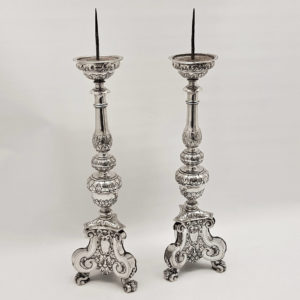
Circa 1650
9583 Antique Silver Pricket Candlesticks
Sold
A tall and imposing pair of antique continental silver candlesticks with baluster stems and vase sconces. Early date. The triform bases stand on shaped scroll feet. Solid silver, probably 80% pure, with loaded interior. Height 46 cm, 55 cm (overall). Stamped on one of the bases with a continental silver stamp. Italian or Netherlands. Circa 1650.
-

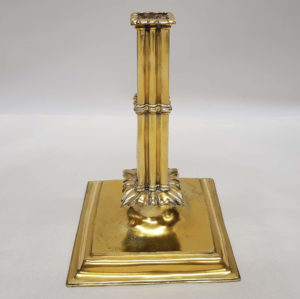
1663
Thomas Hughes
9350 Antique Charles II Pillar Candlestick
Sold
An extremely rare early English silver candlestick from the reign of Charles II. It has a triple pillar column and square stepped base, all with a silver gilt finish. The base is engraved with two contemporary armorials and the motto “Manus Iusta Mardus” for the Maynard family*. Weight 638 grams, 20.5 troy ounces. Height 23.3cm. base 18.3cm square. Stamped underneath in three corners for London 1663. Maker possibly Thomas Hughes* (courtesy of Dr David Mitchell’s “Silversmiths in Elizabethan and Stuart London”). Sterling silver.
-

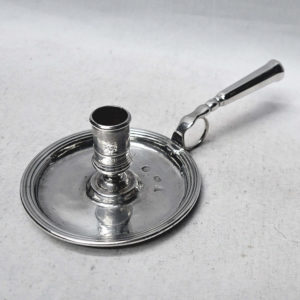
1685
John Penfold
8881 Antique James II Antique Silver Chamberstick
Sold
An extremely rare early English silver chamber stick (also known as a go to bed) with the solid design and excellent heavy gauge silver as you’d expect from this date. It has the early form with a long cannon handle and heavy bordered drip pan with a reeded edge. A nice feature is the ring handle support. The drip pan has hand engraved initials underneath. Weight 223 grams, 7.2 troy ounces. Diameter 11 cms. Length 22 cms. Sterling silver. London 1685. Makers mark probably John Penfold (see photo of Jacksons page 148).
-

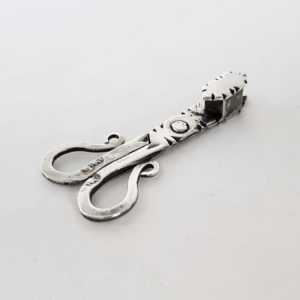
Circa 1685 - 1720
George Manjoy
9764 Antique Silver Miniature Candle Snuffers
Sold
A delightful little collector’s piece. A rare antique silver wick trimmer miniature, also called a candle douter. Britannia standard silver*. Weight 6 grams, 0.19 troy ounces. Length 4.8 cm. Width 2.2 cm. Circa 1700. Maker George Manjoy (c.1685-c.1720), specialist toy maker (see Jackson’s Silver & Gold Marks of England, Scotland & Ireland p.141).
-

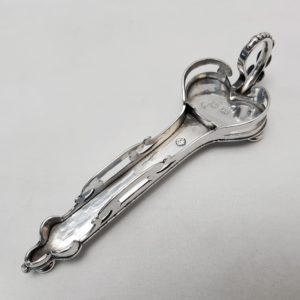
1685
Pierre Harache
10204 James II Antique Silver Snuffer Tray
Sold
A very rare piece of 17th century silver from the highly sought after Huguenot maker Pierre Harache. This Jacobean silver snuffer tray is of triangular form with a pierced gallery to hold a pair wick trimmers (not supplied) snugly in place. Weight 802 grams, 25.7 troy ounces. Spread 17cm. Platform size 14 x 4.8cm. London 1685. Maker Pierre Harache. Sterling silver.
-

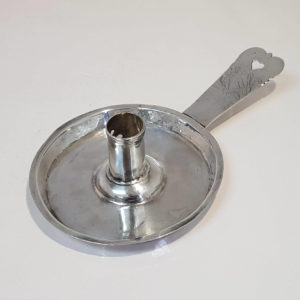
Circa 1693
9664 Charles II to William & Mary Silver Chamberstick
Sold
A rare early English silver chamber candlestick (also known as a go to bed) with the plain styling and hand beaten silver you’d expect from this date. It has a large drip pan and flat tongue shaped handle. The candle socket has 4 circular holes to enable the stub of the candle to be levered out. A nice feature is the shaped handle decoration and heart shaped hole for hanging when not in use. Hand engraved to the handle is an armorial within a decorative cartouche and on the reverse side there are two sets of prick initials and dates. “I.B 1694” and “D.W June 23rd 1693”. Weight 147 grams, 4.7 troy ounces. Diameter 12.9cm. Length 22.5cm. English Sterling silver. Prick marks Charles II to William and Mary date. Circa 1693. No hallmarks. The earliest prick date can be read as either 1664 or 1694 – see photos. In our opinion this is 1664. Makers mark “W.W” unidentified.
-

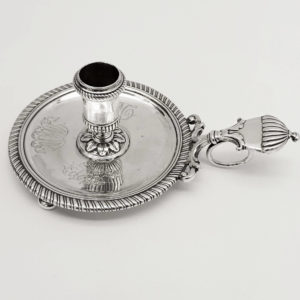
1696
Pierre Harache
9567 William III Silver Chamberstick
Sold
A rare early English silver chamberstick (or “go to bed”) with the solid design and heavy gauge silver you’d expect from this date. Sterling silver. It has the early form with flat teardrop handle. The circular pan has a gadrooned border and ribbed sconce, all mounted on three small stump feet. Hand engraved to the centre are 3 ornamental cyphers. Weight 222 grams, 7.1 troy ounces. Diameter 10.8 cm, 4.25 inches. Length 17 cms. London 1696. Maker Pierre Harache.
-

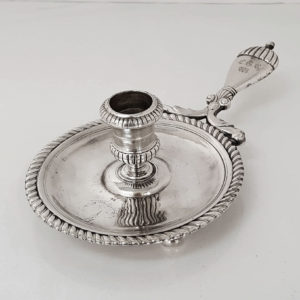
1697
9775 William III Silver Chamberstick
Sold
A rare early English silver chamberstick (or “go to bed”) with the solid design and heavy gauge silver you’d expect from this date. It has the early form with flat teardrop handle. The circular pan has a gadrooned border and ribbed sconce, all mounted on three small stump feet. Hand engraved to one side is a crest and motto. The handle is hand engraved with a set of initials typical of the period. Weight 295 grams, 9.4 troy ounces. Height 6.2 cm. Diameter 11.5 cm. Spread 21.4 cm. London 1697. Makers mark unclear. Britannia standard silver.
-

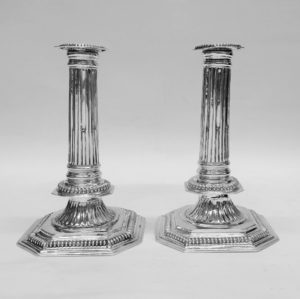
1699
Richard Syng
9170 William III Antique Silver Candlesticks
Sold
A rare pair of early antique silver candlesticks dating from the reign of William III. Britannia standard silver*. Attractive size. These fine candlesticks stand on square canted corner bases with reed columns and multiple gadroon borders. Fixed circular candle sconces. Weight 464 grams, 14.9 troy ounces. Height 18 cms. Base 11.9×11.9 cms. London 1699. Maker Richard Syng, London.
-

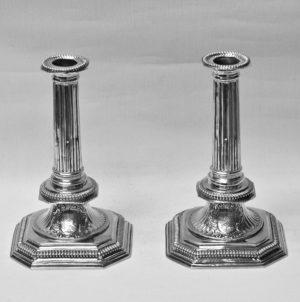
1700
Richard Syng
7924 William III Silver Candlesticks
Sold
A rare pair of early antique silver candlesticks dating from the reign of William III. Britannia standard silver*. These fine candlesticks stand on square canted corner bases with reed columns and multiple gadroon borders. Fixed circular candle sconces. To the front of the base there is a hand engraved coat of arms almost certainly for Gregory de Ligne Gregory (1786-1854). Weight 837 grams, 26.9 troy ounces. Height 23.5 cms. Base 14.25 cms. London 1700. Maker Richard Syng, London.
-

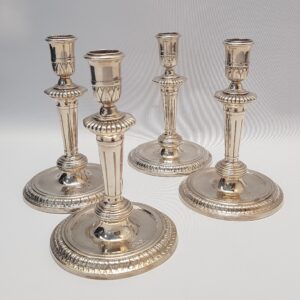
1700
David Willaume
10376 Set of 4 William III Silver Candlesticks
Sold
A handsome set of four antique silver candlesticks, the spreading circular bases with sunken wells and a chased border of foliage. The sticks have a pale gilt finish. Hand engraved to each base is a leopard crest and earl’s coronet. Total weight 1618g, 52 troy oz. Height 17cm. Diameter 10.7cm. London 1700. Maker David Willaume. Britannia standard silver.
-

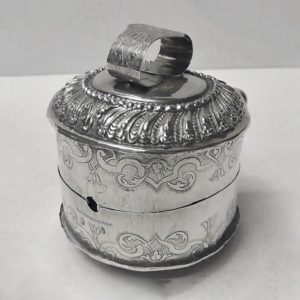
1701 - 1799
8439 Early Continental Silver Bougie Box
Sold
An unusual antique silver wax jack, or taper holder, with cut card work and flower decoration to the body. The wax coil would have been contained inside the drum shaped box. Weight 103 grams, 3.3 troy ounces. Height 8.5 cms. Width 7.5 cms (excluding handle). Diameter 7 cms. Marked on the front with an assay scrape, Nuremberg mark and makers mark. 18th century. German.
-

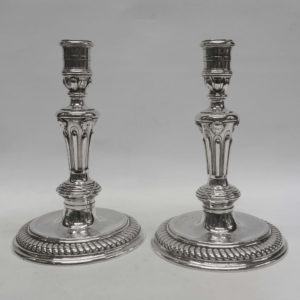
1701 - 1726
David Willaume
9251 Early 18th Century Antique Silver Candlesticks
Sold
A rare pair of tall antique silver candlesticks, the circular bases hand engraved with the Granville coat of arms within a foliate and scroll cartouche. Cast Britannia* standard silver. Total weight 1590 grams, 51.1 troy ounces. Height 22.1 cm. Base diameter 15 cm. The first candlestick is from the William III period, dated 1701 by Pierre Platel. The second candlestick is an exact copy made in the George II period, dated 1726 by David Willaume. Both highly respected Huguenot makers.
-

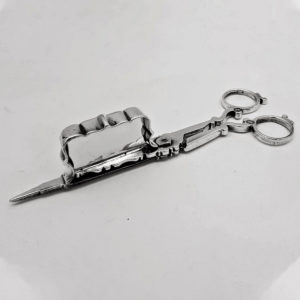
1701
Thomas Brydon
10371 William III Silver Snuffer Scissors
Sold
A rare early English silver candle douter, also called a wick trimmer, with the simple plain style typical of the period. *Britannia standard silver. Weight 94 grams, 3 troy ounces. Length 15.9cm. Width 5.5cm. London 1701. Few snuffers were made prior to 1700. Maker Thomas Brydon, see Jackson’s Silver & Gold Marks page 154, a known snuffers and stand maker.
-

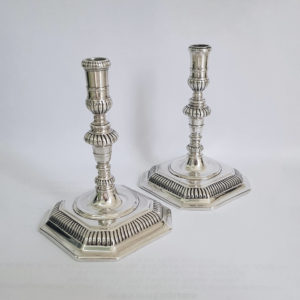
1702
Thomas Prichard
10278 Queen Anne Antique Silver Tapersticks
Sold
A stunning pair of little antique silver tapersticks with square bases and lobed, gadroon decoration. Superb quality. Lovely crisp finish. The technique of making cast silver sticks was introduced into England circa 1685 and this is one of the early designs. Weight 267 grams, 8.5 troy ounces. Height 9.8cm. Base 6.8cm. London 1702. Maker Thomas Prichard. Britannia standard silver. 18th century.
-

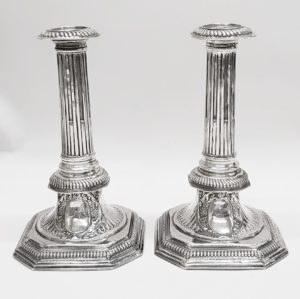
1703
Richard Syng
9427 Queen Anne Antique Silver Candlesticks
Sold
A rare pair of early antique silver candlesticks dating from the reign of Queen Anne. Britannia standard silver*. Good size and weight. These fine candlesticks stand on square canted corner bases with reed columns and multiple gadroon borders. Fixed circular candle sconces. To the front is a large decorative cartouche, typical for this style. Weight 730 grams, 23.4 troy ounces. Height 23cm. Base 14.2×14.2 cms. London 1703. Maker Richard Syng.
-

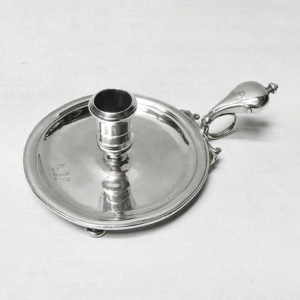
1704
Simon Pantin
7725 Queen Anne Silver Chamberstick
Sold
A rare early English silver chamber stick (also known as a go to bed) with the solid design and excellent heavy gauge silver as you’d expect from this date. It has the early form with a flat teardrop handle and broad drip pan. The circular base is hand engraved with the crest of a crowned lion’s head erased between two plumes, all mounted on three small stump feet. Weight 225 grams, 7.25 troy ounces. Diameter 11.5 cms, 4.5 inches. Length 17 cms. Britannia standard silver*. London 1704. By Simon Pantin.
-

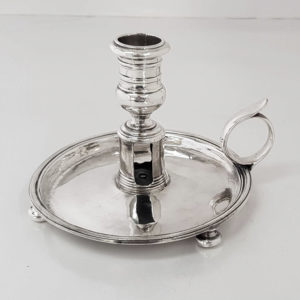
1704
Lewis Mettayer
9773 Queen Anne Silver Chamberstick
Sold
An antique silver chamber stick (also known as a “go to bed”) of plain circular form. Heavy gauge silver. Made in the early style with a ring handle and button feet. Weight 285 grams, 9.1 troy ounces. Height 9.8cm. Spread 14.5cm. Diameter 12.8cm. London 1704. Maker Lewis Mettayer. Of Huguenot origin. Britannia standard silver.
-

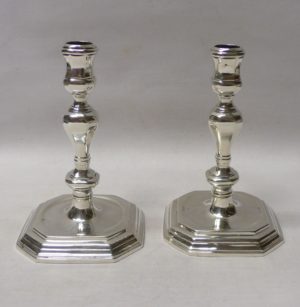
1706
John Eckford
7852 Queen Anne Silver Candlesticks
Sold
A rare pair of early English silver candlesticks. Britannia standard silver*. Lovely plain style and broad bases. Very solid and heavy cast metal with knopped and baluster vase shaped stems and square hollowed out bases with canted corners. Each bears matching two crests and mottos (only traces), possibly marriage crests. One motto, although indistinct, reads ‘True To The End’. Excellent colour. These candlesticks are remarkable for their size and weight. Weight 951 grams, 30.5 troy ounces. Height 17.5 cms. Base 11 cms square. London 1706. Maker John Eckfourd, known for his tobacco boxes.
-

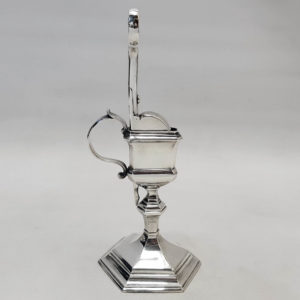
1706 - 1718
Matthew Cooper
10255 Queen Anne Antique Silver Snuffers and Stand
Sold
A rare early English silver snuffers and stand dating to the early 1700’s. The base, with a cast hexagonal stepped base and baluster stem, has the typical style of the candlesticks of this period. The snuffer scissors, known also as wick trimmers, sit longways in the stand, and the pointed end fits snugly into the stand’s retaining slot. Total weight 328 grams, 10.5 troy ounces. Height 22cm. Stand height 13.5cm, base diameter 7.8cm. Scissors length 14.7cm. London 1706/1718. Maker Matthew Cooper. *Britannia standard silver. 18th century
-

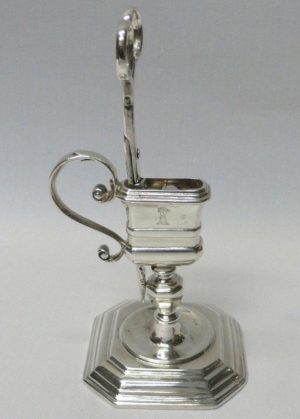
1707
Thomas Folkingham
8034 Queen Anne Antique Silver Snuffers and Stand
Sold
A very rare early English silver snuffers and stand with an octagonal stepped base and baluster stem. *Britannia standard silver. The cut corner square base has the typical style of the candlesticks of this period. The snuffer scissors, or wick trimmers, sit long ways in the stand. Both scissors and stand have identical hand engraved crests of a gauntlet holding up a crown. Total weight 317 grams, 10.2 troy ounces. Height 17.5 cms. Stand height 11.25 cms, base diameter 8 cms. Scissors length 14.25 cms. Both pieces have English silver hallmarks for London 1707. Maker Thomas Folkingham.
-

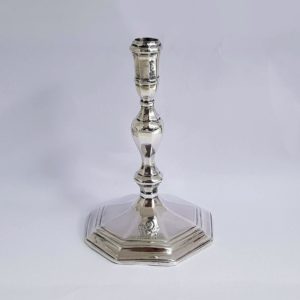
1707
Thomas Merry
10131 Antique Queen Anne Silver Taperstick
Sold
A charming little antique silver taperstick of plain early design with baluster stem and raised octagonal foot. Cast silver. Britannia standard silver*. Hand engraved on the foot is a lion crest. Weight 127 grams, 4.1 troy ounces. Height 11.8cm. Base diameter 7.7cm. London 1707. Maker Thomas Merry.
-

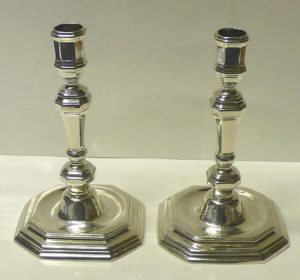
1708 - 1709
Hugues Lossieux De La Vallee
5909 Early French Cast Silver Candlesticks
Sold
A magnificent pair of plain style antique sterling silver candlesticks with faceted columns and having a shaped base and sunken well. Each bears an engraved crest/monogram to the front of the base. Excellent condition and fine patina. Weight 1046 grams, 33.6 troy ounces. Height 20 cms. Base width 12.5 cms. Marked underneath with French silver stamps for Saint Malo 1708-1709. Maker Hugues Lossieux de La Vallee.
-

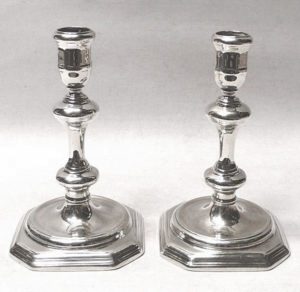
1709
Simon Pantin
7762 Queen Anne Silver Candlesticks by Simon Pantin
Sold
A beautiful pair of rare early English silver candlesticks. Britannia standard silver*. Lovely plain style in keeping with the period. Very solid and heavy cast metal with knopped and baluster vase shaped stems and square hollowed out bases with canted corners. Traces of a crest. Excellent colour. Weight 795 grams, 25.5 troy ounces. Height 16.5cm. Base 10cm square. London 1709. Maker Simon Pantin.
-

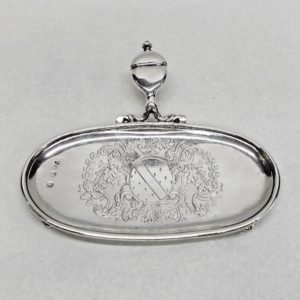
1710
Samuel Lea
9324 Queen Anne Silver Snuffer Stand
Sold
A rare early English silver snuffer tray of oval form with cast acorn handle and three ball feet, similar style to the early chambersticks of a contemporary date. Britannia standard silver*. Hand engraved to the centre with a family armorial contained within a large scroll cartouche. Weight 250 grams, 8 troy ounces. Spread 15.8 cm. Pan 18.6 x 9.2 cm. London 1710. Maker probably Samuel Lea (Charles J Jackson’s “English Goldsmiths and Their Marks”).
-

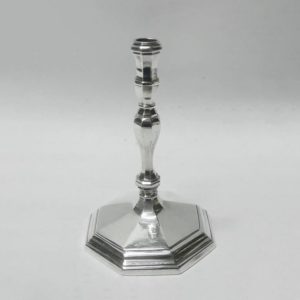
1710
William Twell
7751 Antique Queen Anne Silver Taperstick
Sold
A delightful little antique silver taper stick of plain early design with baluster stem and raised octagonal foot. Cast silver. Britannia standard silver*. Weight 115 grams, 3.6 troy ounces. Height 11.5 cms. Base diameter 7.6 cms. London 1710. Maker William Twell.
-

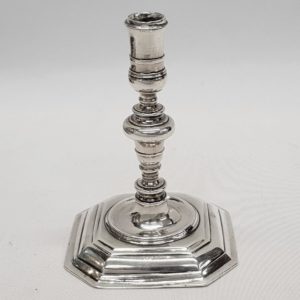
1711
Thomas Merry
9497 Queen Anne Silver Taperstick
Sold
A delightful little antique silver taper stick of plain early design with baluster stem and raised square foot with canted corners. Cast silver. Britannia standard silver*. Weight 104 grams, 3.3 troy ounces. Height 9.5cm. Base diameter 7cm. London 1711. Maker Thomas Merry I.
-

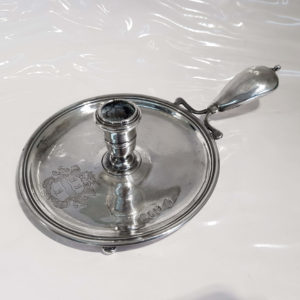
1711
Joseph Bird
10161 Queen Anne Antique Silver Chamberstick
Sold
A rare early English silver chamberstick (also known as a go to bed) with the solid design and excellent heavy gauge silver as you’d expect from this date. It has the early form with a flat teardrop handle and a broad drip pan mounted on three small stump feet. The circular base has a decorative cartouche hand engraved with the coat of arms for the Miller baronets of Chichester, Sussex. Weight 242 grams, 7.7 troy ounces. Diameter 4.5cm. Length 23cm. Britannia standard silver. London 1711. Maker Joseph Bird.
-

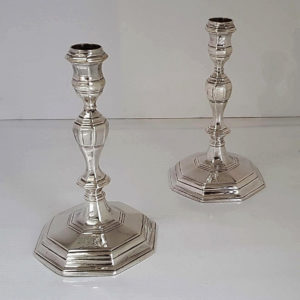
1713
Thomas Folkingham
9770 Queen Anne Antique Silver Candlesticks
Sold
A rare pair of antique English silver candlesticks from the early 1700’s. Britannia standard silver*. Very solid cast silver with octagonal form and baluster columns. Lovely plain style in keeping with the period. Each stick bears a hand engraved lion crest, for the Turnor family, on the base. Excellent colour. Weight 671 grams, 21.5 troy ounces. Height 17.5 cms. Base 10.3 cms square. London 1713. Maker Thomas Folkingham.
These make a matching set of four with #9767.
-

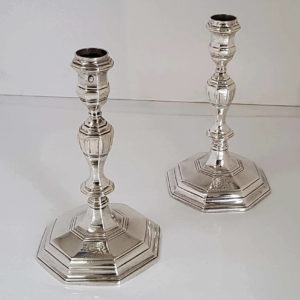
1713
Thomas Folkingham
9767 Queen Anne Antique Silver Candlesticks
Sold
A rare pair of antique English silver candlesticks from the early 1700’s. Britannia standard silver*. Very solid cast silver with octagonal form and baluster columns. Lovely plain style in keeping with the period. Each stick bears a hand engraved lion crest, for the Turnor family, on the base. Excellent colour. Weight 707 grams, 22.7 troy ounces. Height 17.5 cms. Base 10.3 cms square. London 1713. Maker Thomas Folkingham.
These make a matching set of four with #9770.
-

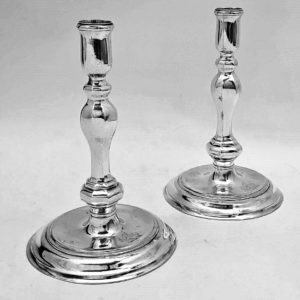
1713
Thomas Merry
9839 Queen Anne Antique Silver Candlesticks
Sold
A fine pair of early English cast silver candlesticks of unusually good size and weight. Britannia standard silver*. Good plain design with circular bases and octagonal stems. Weight 1051 grams, 33.7 troy ounces. Height 21 cm. Base 13.2 cm. Hand engraved to the top of each base is the crest of a lion. London 1713. Maker probably Thomas Merry – see Jackson’s Gold & Silver Marks page 162.
-

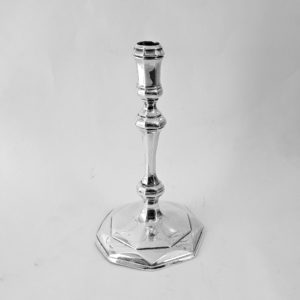
1713
John Barnard
10158 Queen Anne Antique Silver Taperstick
Sold
A lovely little antique silver taperstick of plain design with knopped tapering stem and raised faceted foot. This straight lined octagonal shape is a very rare and desirable feature. Britannia standard silver*. Weight 101 grams, 3.2 troy ounces. Height 12cm. Base diameter 6.7cm. London 1713. Maker John Barnard.